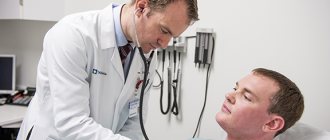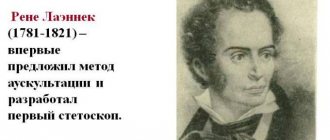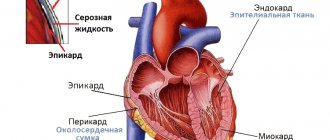Home » Treatment » Heart transplantation: indications, contraindications, results
January 29, 2020 No comments
A heart transplant is a procedure by which a heart is replaced with another heart from a suitable donor. It is generally reserved for patients with end-stage congestive heart failure who are projected to have less than 1 year to live without a transplant and who have not responded to conventional drug therapy. In addition, most transplant candidates cannot undergo other surgical treatment options as a result of poor heart condition.
Candidate identification and evaluation are key components of the process, as are follow-up and management of immunosuppression. Following these steps correctly can lead to an extremely satisfactory outcome for both the physician and the patient.
Heart transplant candidates typically have moderate to severe symptoms. The assessment demonstrates ejection fractions of less than 25%. Attempts are made to stabilize the heart during the evaluation process.
Bridging therapy may include oral agents as well as inotropic support. Mechanical support with an intra-aortic balloon pump or implantable assist devices may be appropriate for some patients as a bridge to transplantation. However, mechanical support does not improve survival in adult patients with congenital heart disease.
The annual incidence of heart transplantation is approximately 1% of all persons with heart failure. Improved medical management of congestive heart failure has reduced the number of candidates; However, organ availability remains a problem.
A heart transplant is the replacement of a faulty heart with a heart from a suitable donor. The 1-year survival rate after heart transplantation reaches 81.8%, and the 5-year survival rate is 69.8%. A significant number of recipients survive more than 10 years after the procedure.
Diseases required for heart transplantation
Diseases that require a heart transplant can be divided into the following categories:
- Dilated cardiomyopathy (54%) – this is often of unknown origin
- Ischemic cardiomyopathy (45%) – this percentage is growing due to an increase in coronary artery disease in younger age groups.
- Congenital heart defects and other diseases that cannot be treated surgically (1%)
The pathophysiology of cardiomyopathy, which may require heart replacement, depends on the primary disease process. Chronic ischemic conditions accelerate myocardial cell damage with progressive myocyte enlargement followed by cell death and scarring. The condition can be treated with angioplasty or bypass surgery; however, small vessel disease is progressive and thus results in progressive loss of myocardial tissue. This ultimately leads to significant functional loss and progressive dilatation of the heart.
The pathological process associated with the functional deterioration of dilated cardiomyopathy is still unclear. Mechanical dilatation and breakdown of energy storage devices appear to play a role.
The pathophysiology of the transplanted heart is unique. Denervation of an organ makes it dependent on its own speed. As a result of the lack of neuronal input, some left ventricular hypertrophy occurs. The function of the right side is directly dependent on the ischemic time to reimplantation and the adequacy of preservation. The right ventricle is easily damaged and may initially function as a passive conduit until repair occurs.
The rejection process that can occur in an allograft has two primary forms, cellular and humoral. Cellular rejection is the classic form of rejection and is characterized by perivascular infiltration of lymphocytes followed by myocyte damage and necrosis if left untreated.
Humoral rejection is much more difficult to characterize and diagnose. It is believed to be a generalized antibody response initiated by several unknown factors. Deposition of antibodies in the myocardium leads to general cardiac dysfunction. This diagnosis is usually made on the basis of clinical suspicion and exclusion; Endomyocardial biopsy is of little value in this context.
IHD is a late pathological process characteristic of all cardiac allografts, characterized by myointimal hyperplasia of small and medium vessels. The lesions are diffuse and can appear any time from 3 months to several years after implantation. The causes of incitement are unclear, although cytomegalovirus (CMV) infection and chronic rejection have been implicated. The mechanism of this process is believed to depend on the production of growth factors in the allograft initiated by circulating lymphocytes. There is currently no other treatment other than retransplantation.
The future of heart transplantation will be determined by the results of several questions. One is the ongoing shortage of donor organs, which has led to the search for alternative treatments for failing hearts. These treatments include assisted devices, dual-chamber stimulation, new drug interventions, and genetic therapy. These efforts have been successful in reducing the need for transplantation. Research in the field of xenografts is ongoing.
First heart transplant: history
Long before person-to-person transplantation was ever introduced to the public, scientists were conducting groundbreaking medical and surgical research that would ultimately lead to today's advances in transplantation. From the late 1700s to the early 1900s, the field of immunology slowly developed through the work of numerous independent scientists. Notable breakthroughs included Ehrlich's discovery of antibodies and antigens, Lansteiner's blood typing, and Metchnikoff's theory of host resistance.
Due to advances in suture techniques in the late 19th century, surgeons began organ transplantation in their laboratory research. There were enough experiments done in the early 20th century to know that xenografts (cross species) invariably failed, allogeneic grafts (between individuals of the same species) usually failed, while autografts (within the same species) the same person, as a rule, skin grafts) were almost always successful. There was also an understanding expressed that repeat transplants between the same donor and recipient are subject to accelerated rejection and that graft success is more likely when the donor and recipient share a common “blood relationship.”
Information appeared in the domestic media that Schwarzenegger received a heart transplant, but this is not true.
The first human heart transplant from a chimpanzee
The first clinical heart transplant was performed at the University of Mississippi Hospital on January 23, 1964 by Dr. James Hardy. This orthotopic transplantation was preceded by extensive animal studies, and the clinical operation fully supported the value of the techniques previously used in the laboratory.
The recipient was a 68-year-old white man, Boyd Rush, in terminal shock from extremely severe atherosclerotic coronary artery disease.
The intended recipient went into terminal shock at approximately 6:00 p.m., with a blood pressure of 70 and virtually no breathing except for the continued use of mechanical ventilation through a tracheotomy tube. Death was clearly imminent, and it was obvious that if a heart transplant was to be performed, it had to be done immediately. - Hardy later recalled in his memoirs.
Hours later, Hardy and his team made history by performing the first heart transplant. The chimpanzee's heart beat for 90 minutes in Rush's chest, but unfortunately was too small to keep his new human body alive. Hardy's patient died shortly after completion of the operation.
At the time of transplantation, the donor heart was well preserved and easily defibrillated. The strong quality of myocardial contractions was recorded using video, and the graft functioned for almost two hours after defibrillation. The progressive state of preoperative metabolic deterioration in the recipient and the size of the donor organ contributed to both the eventual decompensation of the transplanted heart. This first clinical experience clearly established the scientific feasibility of human heart transplantation.
Hardy's decision to use a chimpanzee's heart came under immediate attack from both the public and the medical community. The operation caused intense ethical, moral, social, religious, financial, governmental and even legal problems.
In 2020, former American powerlifter CC Fletcher underwent a heart transplant.
Over the next few months, some of the criticism in the medical community eased after Hardy published an article in the Journal of the American Medical Association in which he described the strict ethical principles he and his team followed in evaluating both donor and recipient.
Even after the first successful human-to-human heart transplant, surgeons continued to experiment with animal hearts. Between 1964 and 1977, hearts from sheep, baboons and chimpanzees were transplanted into at least four adults, all of whom died within days of surgery.
First human-to-human heart transplant
Denise Darvall
On the afternoon of Saturday, December 2, 1967, a tragedy occurred that was to set in motion a chain of events that would make world history.
The family, having gone to visit friends that day and not wanting to arrive empty-handed, stopped opposite a bakery on the main Cape Town Observatory Road. The man and his son waited in the car while his wife and daughter went to the store to buy a cake. A few minutes later they appeared, began to cross the road, and both were hit by a passing car. The mother was killed instantly and the daughter was taken to Groote Schuur Hospital in critical condition and later declared brain dead. This young lady, aged 25, was Miss Denise Darvall.
Only those who have lived through a similar catastrophe can feel what Denise Darvall's father experienced. Faced with the loss of his wife and daughter, Mr. Edward Darwall had the courage and love of his fellow men to agree to the donation of his daughter's heart and kidneys. A human heart transplant without Edward Darwall's permission would be impossible!
The second family in Cape Town was to become inextricably linked to the Darwall tragedy. In late 1967, one of the patients seen by the cardiology department at Groote Schuur Hospital was a 53-year-old doctor from Sea Point. He suffered a series of heart attacks that almost completely disabled his heart muscle. His body was bloated, he could barely breathe, and he was close to death. Doctors and his family, however, recognized the fantastic spirit and courage with which he fought to save his life. His name was Louis Washkansky.
The cardiology department was responsible for the majority of donor patients in the Cardiothoracic Surgery Department at Groote Schuur Hospital. The late Professor Velva Srire, who led this group of specialists, had the foresight and courage to recognize that the surgical methods used at that time could not help all forms of severe heart failure. The meeting of this indomitable patient and the visionary professor of cardiology was another link in the chain of events that were to make history. Dr. Louis Washkansky was ready and brave enough to take the chance on an unexplored surgical treatment, the world's first human heart transplant.
December 3, 1967 Christian Barnard, a South African heart surgeon, speaks with Louis Washkansky after performing the world's first successful human-to-human heart transplant. The heart transplant scar is covered with a bandage.
The head of the Department of Cardiothoracic Surgery at Groote Schuur Hospital at that time was Professor Christian Barnard. He grew up and spent his childhood in the Karoo region, and became a highly skilled and dedicated surgeon and, ultimately, one of the most famous cardiac surgeons of our time. By 1967, he had assembled a team of talented surgeons to assist him. However, in addition to the remarkable surgical abilities of Professor Barnard and his team, the skills of many other disciplines were required. These include:
- cardiologists who assisted in the diagnostic evaluation of the patient and confirmed that the revolutionary surgical procedure was the only possible form of treatment;
- the radiologists and radiologists who provided the x-rays;
- pathologists and their technologists who processed laboratory tests;
- immunologists who have determined that the donor heart will not be rejected by the patient;
- anesthesiologists who provided a safe anesthetic and monitored all vital functions;
- experienced nurses in the intensive care unit and ward who assisted doctors and provided qualified medical care at every stage;
- technologists who operated the lung treatment machine and other equipment;
- a blood transfusion service that ensured the availability of sufficient and safe blood.
Besides these people, there were others who supported the project in the background in different ways. All the individual links in the historical chain were forged, and shortly after midnight that Saturday the operation began. At 6 a.m. on Sunday, December 3, 1967, the new heart in Dr. Louis Washkansky was electrically shocked into action.
The world's first successful human heart transplant took place at Groote Schuur Hospital.
The event brought international attention to Groote Schuur Hospital and created global awareness of the expertise and capabilities of its staff. Professor Barnard undoubtedly had the appropriate training, research experience and the necessary surgical skills to perform this remarkable feat. He also had the vision and courage to accept the medical, ethical and legal risks associated with performing the world's first human heart transplant. However, it must be remembered that this transplant could never have happened without the skills and support of many other disciplines.
What should a donor be like?
The donor is a person with confirmed brain death. These are people who are in a coma after a stroke or emergency.
With the help of medical equipment and medications, the vital activity of the cardiopulmonary system is supported. Therefore, the heart muscle functions even after brain death and is suitable for transplantation.
To remove a donor heart, written permission from relatives or lifetime and legally certified consent of the donor himself is required.
If the intended donor does not have blood relatives or his identity has not been established, organ removal can occur without completing the above documents.
Conditions for heart removal as a transplant:
- the donor must be no older than 65 years;
- the donor should not have infectious diseases that could be transmitted to the recipient;
- the heart must be absolutely healthy;
- the blood groups of the donor and recipient must match;
- the tissues of the donor and recipient must be compatible at the level of the antigenic structure of the receptors;
- the donor's brain death must be recorded and confirmed clinically;
- the difference in the size of the heart muscle of the donor and recipient should not exceed 50%.
The reason preventing transplantation may be a religious factor, because Some religions do not recognize a person as dead if the heart is still functioning.
Another obstacle to organ retrieval may be the distance that must be covered to transport the organ to the appropriate facility. Since the viability of the heart after the death of the donor does not exceed 6 hours.
First heart transplant in the USSR
The first heart transplant in the USSR was performed on November 4, 1968 by a group of surgeons led by Alexander Alexandrovich Vishnevsky. However, information about this operation was classified and not disclosed; it is assumed that the heart transplant was unsuccessful.
A lot of bureaucratic barriers stood in the way of carrying out such an operation in the USSR in subsequent years. The key factor was that brain death was not considered a reason to remove donor organs from a person and transplantation was not permitted in this case. The legislation of that time allowed the removal of organs (kidneys, liver, heart) only from donors with a beating heart. There was a complete lack of logic and sound heart in these laws. Valery Shumakov was a pioneering cardiac surgeon who managed to overcome bureaucratic barriers and perform the first successful heart transplant in the USSR on March 12, 1987. The patient was 27-year-old Alexandra Shalkova.
Who was the first to perform a heart transplant?
Many attempts have been made around the world about heart transplantation, but we will give examples of only the most famous operations that caused a resonance in the public and contributed to the development of the transplantation industry.
| Doctor | Location | Patient | date | Donor | Result |
| James Hardy | Oxford, Mississippi, USA | Boyd Rush | January 23, 1964 | Chimpanzee | The recipient died after 90 minutes |
| Christian Barnard | Cape Town, South Africa | Louis Washkansky | December 3, 1967 | Denise Darvall | Died 18 days later from pneumonia |
| A. A. Vishnevsky | Military Medical Academy, Leningrad, USSR | unknown | November 4, 1968 | unknown | Supposedly the operation was unsuccessful. |
| V. I. Shumakov | National Medical Research Center for Transplantology and Artificial Organs named after V. I. Shumakov | March 12, 1987 | March 12, 1987 | Alexandra Shalkova | Successful operation. The patient died 10 years later. |
When is a heart transplant required?
Today, heart transplant surgery is no longer perceived by people as something fantastic. This procedure has become firmly established in medical practice in many countries of the world, including Russia. Despite the complexity of its implementation, cardiac transplantation is a very popular operation, since the number of heart patients for whom a transplant is the best, and sometimes even the only way to save life and restore health, is quite large.
We can safely say that the history of heart transplantation began in 1967, when South African doctor Christian Bernard transplanted an organ into an elderly terminally ill patient, Louis Washkansky. Despite the success of the operation itself, Louis did not live long and died eighteen days later due to double pneumonia.
Thanks to the improvement of transplantation techniques and the use of drugs that reduce the risk of immune rejection of a transplanted heart, today the life expectancy of patients after surgery exceeds ten years. The patient who lived the longest with a heart transplant was Tony Huseman. He passed away due to skin cancer thirty years after the transplant.
How to live for a child with a new heart
If a heart transplant is performed on an infant, the main rule for a good recovery is a calm environment; the child should not cry too much or strain during feeding. It is important to protect it from contact with strangers in order to minimize the risk of infection.
Walks in the fresh air and good nutrition are required. Visits to a cardiologist are recommended at least once a month after discharge, and then their frequency may be less. School-age children usually find it difficult to tolerate restrictions on movement patterns and communication with peers. But in order to expand the activity regimen, you need to get permission from your doctor.
Gradually, as the heart function is restored, physical activity is increased in the form of physical therapy.
The available results of successful operations prove that with proper treatment and compliance with recommendations, a transplanted heart is not an obstacle to normal life and even sports.
Indications for surgery
The main indication for transplantation is cardiac pathologies at a severe stage, during which treatment with other means is ineffective.
The prerequisite for a transplant is the normal functioning of other organs important to human life and the hope of a full recovery. Therefore, contraindications to transplantation are irreversible renal or liver failure, as well as severe lung disease.
When is a heart replacement indicated?
The main indication for heart transplantation is heart failure.
This pathology is a dysfunction of the myocardium. There are 3 degrees of this disease. In the first degree, shortness of breath with a rapid pulse during intense physical exertion and a slight decrease in working capacity are observed. The second degree is characterized by shortness of breath and palpitations even with light exertion. In the third degree, shortness of breath occurs even at rest. In addition, due to insufficient blood supply, pathological changes develop in other organs - lungs, liver, kidneys, etc.
Heart transplantation is prescribed for patients with third degree heart failure. The progressive development of this disease, leading to the need for a transplant, can be caused by such reasons as
- Impaired ability of the heart to contract due to enlargement of one or both ventricles.
- Severe ischemia accompanied by severe atrophy of the heart muscle.
- Congenital heart defects that cannot be corrected by cardiac surgery.
- Benign tumors in the heart.
- Dangerous incurable forms of arrhythmia.
When is heart transplant contraindicated?
Heart transplantation has its limitations. This operation cannot be performed in cases where it is inappropriate or the risk of negative consequences is too great and therefore unjustified. The main contraindications to heart replacement are various pathologies, which include:
- Sustained pulmonary artery hypertension.
- Infectious lesions of the body that are systemic in nature.
- Systemic pathologies of connective tissue.
- Autoimmune diseases.
- Mental disorders and other factors that complicate communication between doctor and patient.
- Oncological diseases with a malignant course.
- Advanced severe diseases of internal organs.
- Diabetes mellitus without treatment.
- Aggravated peptic ulcers of the stomach and duodenum.
- Viral hepatitis in active form.
- Excessive drinking, smoking, drug addiction.
- Overweight.
If there are diseases that are contraindications for transplantation, appropriate treatment is prescribed, if possible. Only after achieving remission of the disease can the patient be allowed to undergo cardiac transplantation.
There are also age restrictions for transplantation. The age threshold for a heart transplant is sixty-five years. However, in some cases, the operation can be performed on older patients. The decision on the admissibility of a transplant is made by the doctor, based on the health status of the individual patient.
Heart replacement is not performed if the patient refuses the operation or is not ready to comply with medical instructions during the rehabilitation period.
Who does not undergo surgery?
A patient may be excluded from the transplant queue if the following contraindications are found:
- lack of desire to undergo long-term rehabilitation and follow all doctors’ recommendations;
- irreversible narrowing of the pulmonary vessels;
- diabetes mellitus with a tendency to ketoacidosis, identified angiopathy, retinopathy and nephropathy, glycated hemoglobin exceeds 7.5%;
- systemic vasculitis, autoimmune and neurological diseases;
- tuberculosis, HIV, syphilis;
- kidney failure;
- bronchial asthma or obstructive bronchitis with severe respiratory failure;
- previous stroke or transient ischemic attack;
- disorders of the blood coagulation system that are not compensated by medications;
- excess body weight, index over 35 kg/m2;
- addiction to drugs or alcohol;
- mental illness, social instability;
- tumors.
How to do a heart transplant
The heart replacement procedure includes two stages:
- Preparation for surgery.
- The transplant operation itself.
The preparatory stage consists of a thorough examination of the patient’s body to timely identify contraindications for transplantation.
What does preparation for cardiac transplantation include?
During preparation for a heart transplant, the following diagnostic procedures are performed:
- Determination of blood parameters (group, Rh factor, coagulability).
- Blood test for the presence of hepatitis and immunodeficiency viruses.
- Screening for cancer, consisting of a mammogram and smear and cervical sampling for women, and a prostate specific antigen blood test for men.
- Examination for infection with herpes viruses.
Herpes viruses, such as cytomegalovirus, herpes virus and Epstein-Barr virus, can be activated during artificial immune suppression required after transplantation and cause dangerous diseases, including general damage to the body.
In addition to examining the general condition of the body, the heart and adjacent blood vessels are examined. If necessary, bypass surgery or stenting is performed. In addition, the patient must have his lungs checked using X-rays, as well as his external respiratory function.
The preparatory stage also includes medical procedures aimed at relieving existing heart diseases. Therapy includes the use of beta blockers, cardiac glycosides, diuretics, etc.
An extremely important part of preparation for surgery is immunological examination of tissues in accordance with the HLA system. Based on the results of this testing, a suitable donor heart will be selected.
Heart replacement surgery
A person under the age of sixty-five whose life was tragically cut short as a result of an accident, such as a car accident, can become a heart donor for a transplant. The main problem during transplantation is the timely delivery of a donor organ, since the maximum viability of a heart removed from a corpse is six hours from the moment of death. It is advisable to transplant the heart when no more than three hours have passed since it stopped, since tissue ischemia may begin later.
Ideally, a heart for transplantation should be free of ischemia and other pathologies. However, if an urgent transplant is necessary, an organ with minor deviations from the norm can be used.
In addition to tissue compatibility, the criterion for choosing a donor organ is also its correspondence to the recipient’s chest in size. If the heart is too large, it will not be able to function fully in confined spaces.
How is a heart transplant performed?
A heart transplant is a long operation, requiring at least ten hours to complete. Surgery is performed under general anesthesia. The most important task during transplantation is to provide artificial circulation.
The procedure is preceded by repeated blood tests for coagulation and glucose levels, as well as blood pressure measurements. This will allow us to determine the most optimal mode of operation.
Heart replacement involves the following steps:
- disinfection of the operation area;
- longitudinal cutting of tissue above the sternum;
- opening the chest;
- removal of the ventricles of the heart while preserving the atria and the vessels adjacent to them;
- attachment of the donor organ to the atria and vessels;
- suturing fabric.
There are heterotopic and orthotopic heart transplantation. In the first case, the patient does not have his own heart removed, but the donor organ is placed underneath it on the right. This method is labor-intensive to implement and results in compression of the lungs by two hearts, but it is more suitable for patients with high pressure in the pulmonary circulation.
In an orthotopic transplant, the patient's heart is removed and a donor organ is stitched in its place.
After a heart replacement, the patient is prescribed therapy to prevent rejection of the transplanted organ and consists of the use of cytostatic and hormonal drugs.
Rehabilitation period after heart replacement
After surgery, the patient must undergo a myocardial biopsy. In the first month after transplantation, the frequency of this procedure is once every 7-14 days. In the future, biopsies are performed less frequently.
In the early postoperative period, constant monitoring of the hydrodynamics and general condition of the patient’s body is required. It takes 1-1.5 months for the wound left after surgery to heal.
After heart transplant surgery, the greatest danger is the following complications:
- Rejection of the transplant, which can occur either immediately after transplantation or after several months.
- Opening of bleeding.
If there is bleeding, repeat surgery is required to correct the problem.
Complications due to infection in the wound are also possible. To prevent them, the patient is prescribed antibacterial drugs.
Currently, more than 85% of patients survive the first year after transplantation. About half of patients live longer than ten years after transplantation.
Normally, the duration of uninterrupted operation of the transplant is from 5 to 7 years. Subsequently, aging and atrophy processes begin in the organ, which proceed much more intensely than in a healthy heart. As a result, donor organ failure gradually develops. For this reason, the life expectancy of people with a transplant is less than the statistical average.
Recovery after
The most difficult stage after surgery is the first weeks, as the body must adapt to new blood circulation conditions and foreign antigens. Most often, the success of treatment depends on the progression of right ventricular failure. Almost all patients experience rhythm disturbances and weakness of the sinus node. Combined left- and right-ventricular hemodynamic decompensation is also considered an unfavorable sign.
If the donor heart was injured, there were metabolic disorders, and a long period of hypoxia, then large doses of cardiotonic drugs are required. The prognosis in such cases is often unfavorable.
Restoration of heart function begins only by day 3. After cardiac output has stabilized, the patient is transferred from the intensive care unit to a regular ward, and most medications are allowed to be taken in tablet form.
Features of the clinical manifestations of a transplanted heart are:
- no pain even with severe ischemia;
- high heart rate at rest, it does not change during the phases of the respiratory cycle or changes in body position;
- paradoxical reaction to medications;
- There are 2 P waves on the ECG.
Cyclosporine after heart transplantation
Most patients are shown a triple regimen of cytostatics and hormones using Cyclosporine, Methylprednisolone and Azathioprine. With a significant decrease in immunity, bacterial infections occur, which requires the inclusion of antibiotics in the regimen.
The most serious complication is graft rejection. It can begin at different times, so patients must be constantly under the supervision of doctors after discharge from the hospital and undergo a full examination, including a biopsy.
Complications at an early stage
Most often, the new organ is rejected. To prolong life after a heart transplant, patients are required to take medications that inhibit the synthesis of T-lymphocytes. Moreover, the use of these drugs is lifelong.
Clinical symptoms of rejection may vary. First signs:
- weakness;
- elevated temperature;
- dyspnea;
- migraine.
Treatment of rejection consists of administering increased dosages of glucocorticosteroids, performing plasmaphoresis and other measures aimed at removing toxic substances.
Another complication is infectious diseases, which are the result of a decrease in human immunity.
Late stage complications
After several years, the likelihood of infections and rejection decreases significantly. But a person faces other complications, the most common being a decrease in the lumen of the capillaries. This is the leading cause of death in late stages after transplantation.
The problem of capillary narrowing can only be determined when all complications can be overcome in the early stages. Today, doctors are successfully coping with this pathology. Saving a life after replacing a person’s heart is possible only if the narrowing of the arteries is diagnosed in a timely manner.
Today, heart transplantation is the method of choice for many patients with cardiovascular diseases. The number of people who have already had this operation increases every year. Despite the fact that transplantation carries many complications, this operation is in great demand.
How much does a heart transplant cost?
Heart transplantation is a very expensive operation, as it requires highly qualified doctors and the availability of modern, expensive equipment. In Russia, a heart replacement costs about 100 thousand dollars, and in Western European countries and the USA - from 300 to 500 thousand dollars. The price in Western countries is much higher, but this price includes all postoperative care.
However, the patient has the option of a free heart replacement. To do this, the patient must be on a waiting list for a heart transplant. However, due to the shortage of organs for transplantation, free operations are very rare and many people in need of a transplant do not wait for their turn.
| Heart transplant | |
| Heart transplant in Moscow | Heart transplant in Krasnodar |
| Heart transplant in Krasnoyarsk | Heart transplant in Novosibirsk |
| Heart transplant in Rostov-on-Don |
Similar articles on the topic of transplantation
- Liver transplantation: indications, how...
- Cornea transplantation (keratoplasty): procedure…
- How much does surrogacy cost in Russia?
- Pig heart transplant to human
- Heart transplant in Moscow
- Heart transplant in Krasnoyarsk
Indications and contraindications for heart transplantation
Heart transplantation is indicated for extremely severe diseases that are not amenable to drug therapy and lead to severe heart failure. Reasons for such conditions:
- dilated cardiomyopathy;
- birth defects;
- valve pathology;
- severe disturbances in the systolic function of the heart (ejection volume less than 20%);
- malignant recurrent angina;
- atherosclerosis of the coronary arteries, not subject to other surgical interventions;
- neoplasms.
The issue of heart transplantation is decided by a council of leading specialists. There, the surgical risk and further prognosis of a particular patient are assessed.
Contraindications:
- active infectious process;
- systemic diseases (SLE, rheumatoid arthritis);
- AIDS;
- insulin-dependent diabetes with organ damage or frequent decompensation;
- blood clotting disorder;
- obesity;
- severe diseases of the liver, kidneys, lungs;
- amyloidosis;
- malignant neoplasms;
- mental disorders;
- atherosclerotic lesions of peripheral and/or cerebral arteries;
- severe pulmonary hypertension;
- repeated pulmonary infarctions;
- alcohol, drug and tobacco addiction;
- elderly age.











